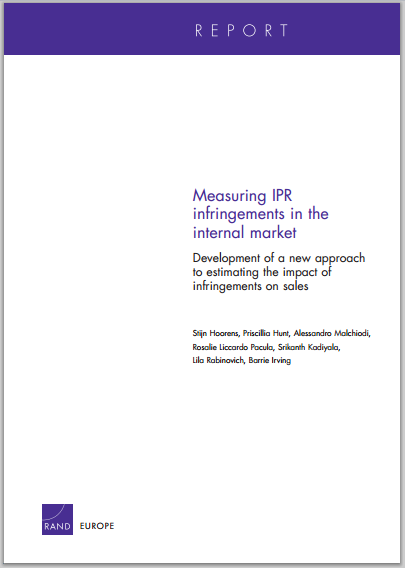Aan EU Observatory aangeboden rapport over meetbaarheid IE-inbreuken
 Op 27 september 2012 is het bovenstaande rapport gepresenteerd aan de inaugurele plenaire bijeenkomst van de European Observatory on Infringements of IP Rights in Alicante.
Op 27 september 2012 is het bovenstaande rapport gepresenteerd aan de inaugurele plenaire bijeenkomst van de European Observatory on Infringements of IP Rights in Alicante.
Objectives of this study Given the intensity of the debate around IPRs, echoed in the controversy around the ratification of the Anti-Counterfeiting Trade Agreement (ACTA) for instance, and the potentially significant economic and other interests that play a role, an objective and evidence-based approach towards measuring the scale and impact of the phenomenon has become more important than ever. This study was set up to assist the Internal Market and Services Directorate General (DG MARKT) of the European Commission and the European Observatory on Infringements of Intellectual Property Rights in the development of a methodology that would quantify the scope, scale and impact of IPR infringements on the European economy. This study is the first stage in an attempt to continuously assess the problem and to develop evidence-based policies in the area of IPRs.
In order to address this objective, we have formulated a number of research questions that this report aims to answer:
1. What can we learn from previous efforts about the drivers and impacts of IPR infringements?
2. What are the strengths and weaknesses of existing methodologies that have been applied to measure the scope, size and impact of IPR infringements?
3. What does this mean for the development of a methodology to be applied by the European Commission to estimate the scale of IPR infringements in the internal market?
4. What would be the characteristics and data requirements of such a methodology?
5. What does application of this methodology teach us about the scale and impacts of IPR infringements in the internal market?
6. What are the benefits of this methodology in comparison to alternatives?
7. What are the challenges and limitations of this methodology; can they be tackled, and if so, how?
8. What are the next steps that need to be taken in order to assist the European Commission in its ambition to measure the development of IPR infringements in the internal market on an annual basis?
As the remainder of this report will clarify, most of these questions have been addressed. However, several challenges remain. Based on the lessons from previous studies, we decided to focus our attention on the impact of IPR infringements on the sales of legitimate goods and products. We have developed a methodology that can be used to monitor the trends in this area.
While this is only one of the potential impacts of infringements, the study acknowledges that measurement of other impacts (e.g. on innovation, growth, competitiveness, creativity, culture, public health and safety, employment, environment, tax revenues and crime) cannot advance unless the measurement of infringement itself has reached a scientifically satisfactory stage.
In this report we offer the ‘building blocks’ for a methodology that is consistent, robust, feasible and reliable in measuring the size of counterfeiting and UUPC. In a next stage it would then be sensible to work on improving the methodologies that are currently applied to the study of the broader impacts of infringement.

























































































